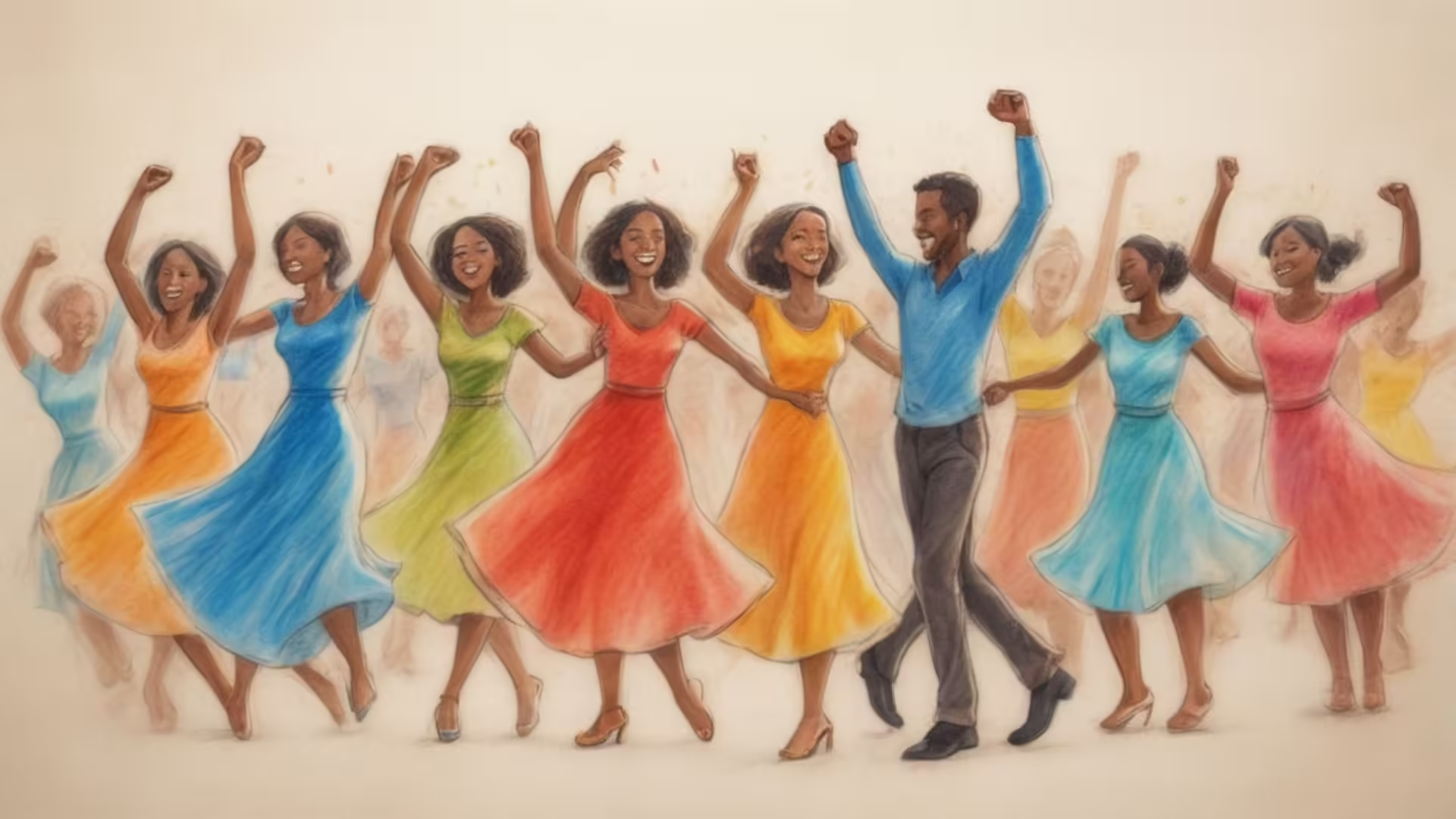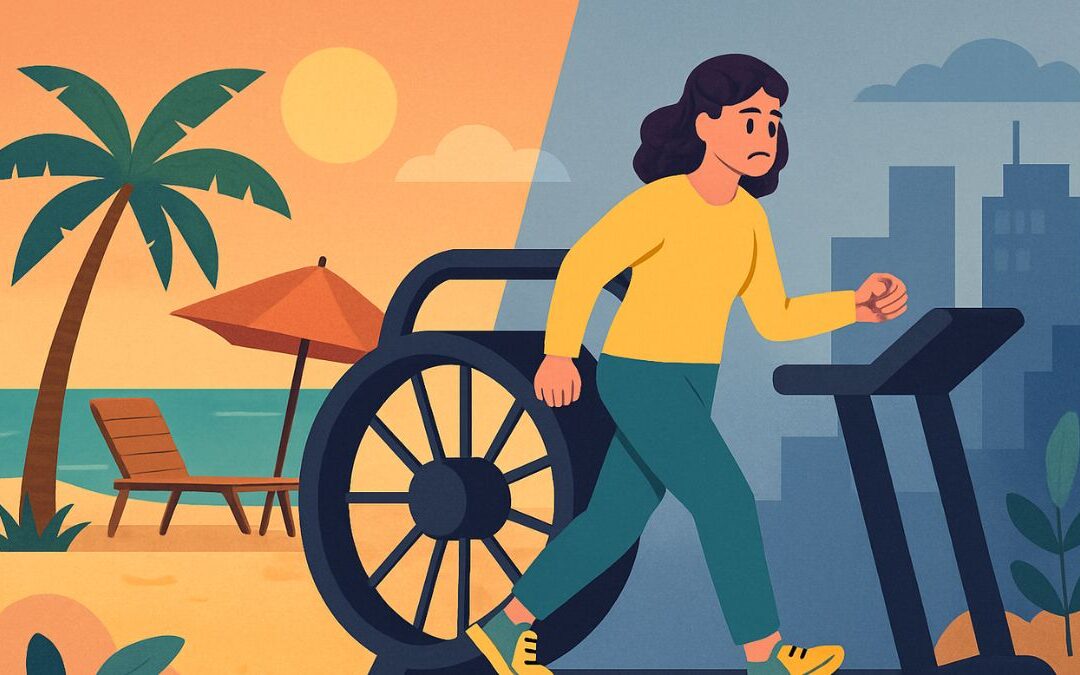- The Gist
- Why Synchronizing Actions Increases Connection
- How Synchronization Affects Group Cohesion
- The Science Behind Synchronized Movements and the Brain
- Practical Benefits of Synchronizing Actions
- Examples of Synchronized Activities to Try
- How Synchronized Activities Can Impact Personal Relationships
- The Psychological Impact of Synchronization on Happiness
- Embracing the Power of Synchronization
- Let’s Talk
- Let’s Learn Vocabulary in Context
The Gist
Why Synchronizing Actions Increases Connection
Humans are social creatures, and one way we strengthen social bonds is through synchronizing our movements with others. This could mean dancing in unison, singing in a choir, or even walking together at the same pace. Studies in psychology and neuroscience have shown that when we move in rhythm with other people, our brains release endorphins, the “feel-good” chemicals that lift our mood and increase feelings of connection. Synchronizing actions with others actually helps us bond on a deeper level, building trust and encouraging cooperation.
Our brains are wired to respond positively to these kinds of activities. When we dance or move in sync with someone, our brains release oxytocin, often called the “bonding hormone.” This hormone is typically associated with close relationships and feelings of affection, and it plays a big role in why synchronizing actions makes us feel closer to others. Moving together makes us feel as though we’re “in tune” with one another, and this connection extends beyond the activity itself, influencing how we feel about each other afterward.
How Synchronization Affects Group Cohesion
Synchronized activities have a powerful effect on group cohesion. When people act in unison, they experience a sense of unity and collective identity. Think of a team sport where players coordinate their movements to win a game, or a dance group that moves in perfect harmony. Research shows that groups who engage in synchronized activities develop a stronger sense of unity and even tend to help each other more.
This feeling of unity isn’t limited to physical activities. Any activity that involves working together rhythmically—like chanting, drumming, or even clapping in sync—can lead to a deeper sense of cohesion. In one study, participants who sang in a choir together reported higher levels of social closeness than those who sang solo. When we synchronize with others, we not only share an experience but also start to feel like part of something larger than ourselves, creating a shared identity.
The Science Behind Synchronized Movements and the Brain
The science behind synchronizing actions lies in a phenomenon called interpersonal synchrony, which is when our movements, emotions, and even heart rates align with those of others. When we move in sync, our brainwaves begin to mirror each other’s, creating a unique kind of mental connection. This process has roots in our evolutionary past, as early humans relied on synchronized activities for survival, like hunting in groups or performing ritual dances.
Mirror neurons in the brain play a key role here. These neurons fire both when we perform an action and when we observe someone else performing the same action. So, when we see others moving in sync with us, our mirror neurons activate, reinforcing the sense that we’re all “on the same wavelength.” This mirroring effect helps us understand and connect with others on a nonverbal level, strengthening our social bonds.
Practical Benefits of Synchronizing Actions
Aside from boosting feelings of connection, synchronizing actions with others has practical benefits. For example, team sports, group exercise classes, and collaborative projects all use synchronized movements to build trust and coordination. When people feel in sync, they work together more effectively, leading to better teamwork and improved outcomes.
Even in less obvious settings, synchronization can enhance connection. For instance, companies often use team-building activities to encourage employees to work together rhythmically, whether through problem-solving exercises or outdoor activities. By encouraging employees to move and think in harmony, workplaces can build a stronger sense of unity and teamwork.
Examples of Synchronized Activities to Try
If you’re curious about the bonding effects of synchronized actions, there are plenty of ways to incorporate them into your daily life. Here are a few simple examples:
- Dancing: Whether it’s a dance class or a spontaneous dance party, moving to the beat with others boosts connection and mood.
- Singing or playing music: Joining a choir, band, or drum circle allows you to connect through rhythm and harmony.
- Exercise classes: Group fitness activities like aerobics, cycling, or Zumba offer a structured way to move in sync with others.
- Martial arts: Many martial arts incorporate synchronized moves that emphasize unity and discipline.
- Yoga or meditation classes: Although more subtle, synchronized breathing and movements in these classes create a shared, calming experience.
How Synchronized Activities Can Impact Personal Relationships
Synchronizing actions with others can improve personal relationships by fostering a deeper sense of understanding and connection. Couples, for instance, may feel closer when they dance, hike, or even cook together in a coordinated way. Families can also benefit from synchronized activities like playing sports, taking walks, or doing yoga together, creating shared memories and a sense of closeness.
Synchronized activities can even improve communication in relationships. When people feel more connected, they’re likely to be more open and understanding with each other. This is especially true in romantic relationships, where studies show that couples who move or dance together report higher levels of satisfaction and affection.
The Psychological Impact of Synchronization on Happiness
One of the reasons synchronized activities feel so rewarding is because they reduce stress and boost happiness. Physical movement, combined with social connection, releases endorphins and oxytocin, which improve our mood and increase overall well-being. Engaging in synchronized activities offers a natural way to relieve stress, improve mood, and foster a sense of fulfillment.
The benefits extend to mental health as well. For people who may feel isolated or lonely, participating in synchronized activities can create a much-needed sense of belonging. Joining a class or community group where people move, sing, or work together rhythmically can help reduce feelings of loneliness and build a supportive social network.
Embracing the Power of Synchronization
Synchronizing actions with others is more than just a fun experience—it’s a powerful way to strengthen connections, build trust, and boost happiness. From dancing to group workouts, these activities tap into our natural need for social connection and create lasting bonds. Whether you’re looking to improve teamwork, deepen personal relationships, or simply enjoy a sense of unity, synchronized actions offer a simple and enjoyable way to connect. Embracing these activities reminds us of the strength we find in unity, helping us feel more connected to others and more in tune with ourselves. So, the next time you get the chance to move in sync with others, go for it—it just might be the boost you need.
Let’s Talk
Isn’t it amazing to think that dancing, singing, or even just walking in sync with someone else can actually make us feel closer to them? It’s such a simple thing, and yet it taps into something so fundamental in how we connect with each other. And it’s not just limited to dancing in a club or singing along at a concert—it turns out that any activity where we move or act in sync, like a group workout, even a team project, can bring us together on a deeper level.
So, have you ever felt that connection when you’re dancing with a friend or singing in a group? There’s this unspoken feeling, like you’re on the same wavelength. Scientists would say it’s our brain releasing all the right bonding chemicals—endorphins, oxytocin, the works. But beyond the science, there’s something about being “in sync” that just feels right. Maybe it’s the fact that, for a moment, everyone’s part of something bigger, moving as one.
And let’s not forget the practical side of this. Imagine you’re in a team setting at work. Ever notice how things feel smoother when everyone’s on the same page, literally working in sync? It’s like a dance. When each person steps in rhythm, trust builds, and the whole project just flows. Compare that to a situation where everyone’s doing their own thing—it’s like a dance with no music, and let’s be honest, it doesn’t feel quite as fulfilling.
What’s funny is that we see this idea in everyday moments we don’t even think about. Walking in step with someone, clapping along to a song, laughing at the same time as a friend—these little things make us feel connected. And you don’t have to be the world’s best dancer or singer to get that feeling. The next time you’re with a group, see how it feels to sync up, even if it’s just tapping to a beat. It’s a simple thing, but the effects can be surprisingly powerful.
Have you ever had one of those experiences where you felt totally in sync with a group, even if it was just for a moment? And do you think we could use this idea of synchronized actions more intentionally, maybe to bring people together or make challenging tasks feel easier? It’s fun to think about all the ways we can find connection, sometimes without even saying a word.
Let’s Learn Vocabulary in Context
Let’s explore some of the interesting words and phrases we used in talking about synchronized activities and how they boost our sense of connection. These words are not only useful for understanding group dynamics but can also add some color to your everyday conversations.
First up is synchronized. To be synchronized means to move or act in harmony with others. We see this in activities like dancing or group sports. You might say, “Our schedules finally synchronized, so we could meet up for coffee!” meaning they aligned perfectly.
Then we have endorphins, which are those “feel-good” chemicals our brains release. They’re often associated with exercise, but they also show up when we laugh or even when we feel connected to others. For example, “That run gave me a rush of endorphins, and I felt amazing afterward.”
Oxytocin is often called the “bonding hormone.” It’s released when we feel close to others, whether through a hug, a shared laugh, or, yes, dancing together. You might say, “Just petting my dog releases oxytocin—it’s so calming!”
Next, let’s look at connection. This word is all about feeling close to others, whether through shared experiences or understanding. You could say, “Even though we just met, we had an instant connection.”
Cohesion describes the sense of unity in a group. When people feel cohesive, they feel like a team, even if they’re from different backgrounds. You might say, “The cohesion in our group made the project so much easier to handle.”
In tune is a phrase we use to describe being on the same wavelength as someone else. Musically, it means being in harmony, but in everyday life, it can mean understanding each other well. You might say, “My best friend and I are always in tune with each other’s feelings.”
Mirror neurons are brain cells that help us empathize by mirroring others’ actions or emotions. When you see someone yawn and feel like yawning, that’s your mirror neurons at work. In conversation, you might use this idea by saying, “Seeing her excitement about the trip made me excited, too—must be those mirror neurons!”
Bonding is all about forming connections and building trust. We bond over shared interests or experiences. You might say, “We bonded over our love for hiking and ended up planning trips together.”
Group dynamics refers to how people interact within a group, like in team sports, work projects, or even social gatherings. You could say, “The group dynamics at the meeting were positive, and we all worked well together.”
Finally, unity is the sense of togetherness, a feeling that people are working toward a common goal. You could say, “There was a sense of unity at the concert when everyone sang along to the same song.”
Here are a couple of questions to think about: Have you ever felt more connected to someone after doing an activity together? And what kinds of activities do you think help create that feeling of unity?










0 Comments